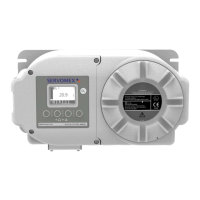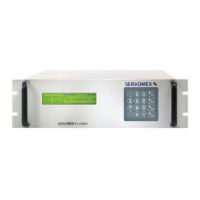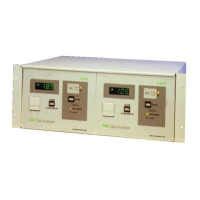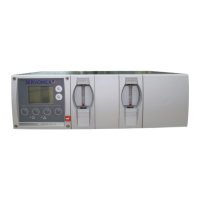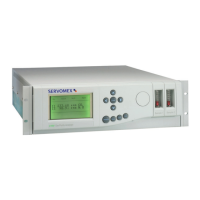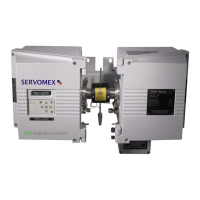5200 Multi Purpose and 5200 Multi Purpose HF Gas Analysers
05230001A / Revision 9
39
6.3 Correcting oxygen measurement for different background gases
6.3.1 Overview of measurement errors
For an oxygen sensor, the composition of any typical background gas in the gas
sample will have a negligible effect on the Multi Purpose measurement. For a Multi
Purpose which has been ’Lo’ calibrated with nitrogen and ’Hi’ calibrated with oxygen,
the cross-interference errors (that is, oxygen measurement errors) in gases which
contain 100% of a specific background gas will be as shown below:
Note that the error is directly proportional to the concentration of the background gas
in the sample being measured, and in most cases can be ignored.
If you cannot ignore the error, you can use the procedure in Section 6.3.2 to enter a
compensation to correct for the error.
6.3.2 Entering a cross-interference compensation
Use the following procedure to enter a compensation to correct for an oxygen
measurement error:
1. Press the soft key to display the Menu screen, use the and soft
keys to highlight the "Set up" menu option, then press the soft key. The Set
up screen will then be displayed (see Figure 17).
+
If you are measuring oxygen in a background of nitrogen or air, you do not
need to correct the measurements.
Background gas Error Background gas Error
Argon -0.22% Krypton -0.49%
Carbon dioxide -0.26% Neon -0.15%
Halothane -1.93% Nitrous oxide -0.20%
Helium -0.29% Xenon -0.92%
+
You can only apply cross-interference compensation to oxygen sample
measurements. You must not apply cross-interference compensation to IR
gas measurements.
+
Cross-interference compensation is disabled during calibration, and is not
applied to the values shown in Figure 21. All other outputs (that is, serial or
milliAmp outputs) remain compensated.
